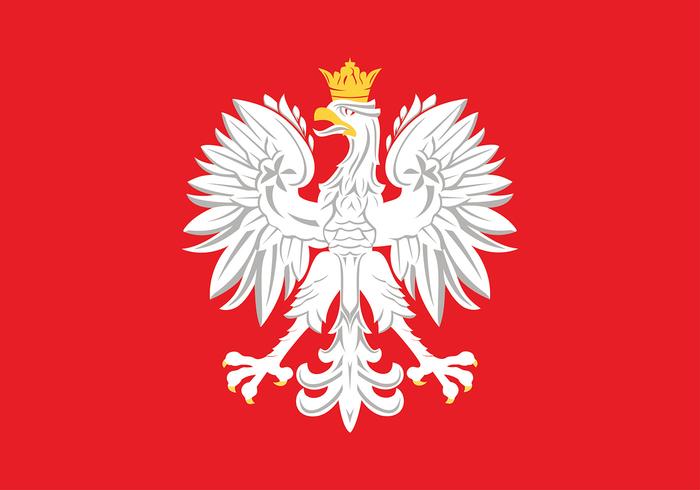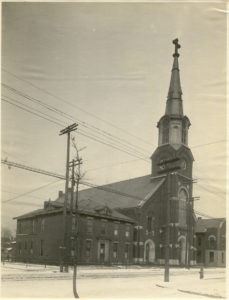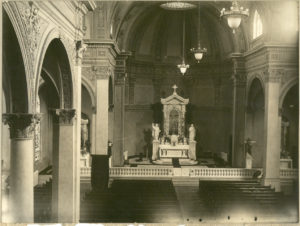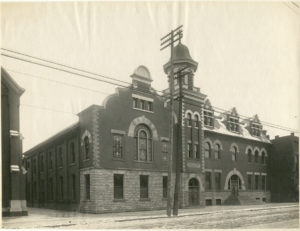St. Peter Parish
| Toledo Polish Churches > St Peter Parish
St. Peter Parish: the German Catholic Church near Kuhschwanz Originally named in honor of St. Peter, this parish later became known as Saints Peter and Paul. In 1866, Bishop Amadeus Rappe of Cleveland asked Father Peter Dannenhofer to found a new parish in Toledo to serve German immigrants. Father Dannenhofer purchased four lots along South Saint Clair Street and Hobart; he and 65 families headed by farmers and artisans built a two-story brick church measuring 34 feet by 80 feet. There were three large windows on the second floor, a large main door with two side doors and rounded tower with a simple cross. Father Dannenhofer said the first Mass in Saint Peter Church on December 8, 1866. When the first Poles arrived in Toledo after the American Civil War, some settled along Nebraska Avenue in the Kuhschwantz (cow’s tail) neighborhood. There was no Polish church for these immigrants; they walked to Saint Peter on South St. Clair Street. Since many Poles emigrated from Prussian Poland, they knew the German language. By 1873, the congregation outgrew the church; Bishop Richard Gilmour of Cleveland laid the cornerstone for a new church in August, and Bishop C. Henry Borgess of Detroit dedicated the church on December 12, 1875. The old church/school building was remodeled, making that entire building the school; additional excpansion and remodeling of the school took place at the turn of the century. In 1880, the congregation added a spire to the church, and in 1895, they added three bells, named Saint Peter, Joseph-Bernhard and Angelus. Within three years, the parishioners paid off the debt of $40,000 from contributions and picnics and church fairs on the Oliver Street grounds. Father Dannenhofer celebrated the silver anniversary of his ordination to the priesthood on June 28, 1888; 60 priests and his parishioners attended the Jubilee Mass and banquet. They gave him $1,500, a gold chalice and a horse and buggy. Here is a revealing story about this pastor from an early church history: “It was not unusual to find him sitting at home on the coldest winter nights with no fire in the house, because he had not the price of a load of wood and would not borrow the money for fear of raising the debt of the church.” The councilmen, in turn, stayed up Saturday nights sawing and splitting wood to keep the church warm for Sunday Mass. Another jubilee came quickly, the 25th anniversary of the parish. Preparations included renovations to the church, including three new altars of dark-stained oak embellished with gold, a sculpture of the crucifixion on the main altar, new Stations of the Cross and statues of St. Peter and St. Paul. After the celebration on December 9, 1891, Father Dannenhofer found it difficult to fulfill all his duties; assistant priests helped the parish. The pastor died on April 29, 1898. He had kept the parish debt-free for 12 years, built a rectory and converted the original church into a school staffed initially by the Franciscan Sisters of Joliet, Illinois. The Franciscans of Rochester, Minnesota took over after three years, and lastly the Franciscan Sisters of Sylvania, Ohio taught the parish children. He loved the school children. During his tenure, the original number of families increased to 350 families. When Father G. H. Rieken was pastor, the Diocese of Toledo was created with Bishop Joseph Schrembs as its head. It was about this time that the parish began to be known as Saints Peter and Paul. The influential Father Henry E. Boesken was pastor of Saints Peter and Paul Church for 30 years, beginning in 1912. He led the parish through the hard years of World War I and the Great Depression. The church was wired for electricity in 1913. Bishop Schrembs created Saint James Church out of the parish territory. Father Boesken opened a ninth grade called a commercial grade at the school. The Golden Jubilee was celebrated in 1917, a year late because of bad weather. The church and the school were repainted. Redemptorist missionaries preached a mission in the spring. On May 20, 1917, Bishop Schrembs, Bishop Michael J. Gallagher of Grand Rapids, Michigan and Bishop Patrick R. Heffron of Winona, Minnesota consecrated Saints Peter and Paul Church, the first church in Toledo or Cleveland to be so honored. Five years later, the parishioners pledged a weekly amount to support the church and school. This envelope system replaced pew rent, monthly collections, special collections, and fundraisers. In one year, revenue increased 75%. Saints Peter and Paul had 300 families with 1,250 individuals. The school had 188 pupils with 30 enrolled in high school. On Sunday, February 7, 1926, Miss Mae Kraft, the parish secretary saw smoke coming from the church basement. Father Boesken removed the Blessed Sacrament, the vestments and sacred vessels. Damage was estimated at $95,000 due to fire and smoke, and the water caused the choir loft and organ to crash onto the church floor. After raising $50,000, the church was reopened on November 11, 1926 with a white Italian marble altar decorated with Venetian art glass and an organ with 1660 pipes, 69 bars, chimes and a harp. In 1930, St. Peter’s Cemetery at Wayne Street and Western Avenue was closed, and the bodies were removed to Calvary Cemetery. Father Dannenhofer bought the land from George and Dorothy Fey in 1870, but he gave it to Bishop Gilmour in 1872. Commodore Perry VFW Post No. 3338 bought the land for $6,500 in 1952. Father Boesken became Monsignor Boesken in 1934; he celebrated his silver anniversary as pastor in 1937. He retired in 1942 and moved to Maumee, and later to Broadway. Monsignor Boesken died on June 21, 1944. Father Frederic Wilhelm led the parish through World War II. Seventy-one men served in the armed forces, and four were killed on duty. Mrs. Carl F. Hehl, secretary of the SS. Peter and Paul Servicemen’s Guild, sent a mimeographed newsletter called “Peter Paul Patter” in 1945. Improvements and changes continued throughout the 1950’s and 1960’s. Pastor Monsignor John Vogel noted that 71% of schoolchildren had a television set in their homes in 1952. How would this influence their learning? He also visited the first black family in the neighborhood to invite them to church; he thought that this marked the “beginning of a population shift” for South Toledo. Father Marcellus Lambillote initiated extensive remodeling to the church, school, rectory and land. The city of Toledo built a new bridge across the Maumee River in the South End, the I-75 bridge, and the U. S. Government erected the Main Post Office in the neighborhood. As a result of these projects, the parish lost 40 families, but income increased. Father Lambillote left the parish with no debt and a reserve fund. The parish had been involved with the Mexican Mission since 1927. In March of 1963, it merged with Our Lady of Guadelupe Mission for Spanish-speaking Catholics, which was three blocks away. The merger increased school enrollment from 102 to 150 and parishioners to 2,000. The school merged with Immaculate Conception School in 1983 as Queen of Peace School and with Saint James School in 1992 as Queen of Apostles School. Father William L. Richter spoke Spanish and reached out to Spanish-speaking people by holding an open house and sponsoring the first Cursillo in the Diocese of Toledo. Project Headstart, a federal program to prepare four and five year olds for school found a home in the school. On November 25, 1966, the parish observed its centennial with a Pontifical High Mass and reception. The parish gave gold centennial programs and commemorative silver medals engraved in Germany to everyone at the Mass. Through the years, the people participated in many organizations, especially the St. Vincent de Paul Society founded in 1927 to raise money for the poor, the Holy Name Society founded in 1951 to sponsor youth activities, and the Altar and Rosary Society founded in 1953 to involve women in a variety of services to the parish. Saints Peter and Paul Church continues to serve a bilingual population. Pastors of Saints Peter and Paul Parish: Reverend Peter Dannenhofer (1866-1898) Reverend Wilmar Mueller (1898-1904) Reverend Gustave H. Rieken (1904-1912) Reverend Henry Boesken (1912-1942) Reverend Frederic Wilhelm (1942-1949) Reverend John Vogel (1949-1953) Reverend Marcellus T. Lambillotte (1953-1963) Reverend William L. Richter (1963-1967) Reverend Richard G. Miller (1967-1973) Reverend Francisco Caballero (1973-1976) Reverend David J. Beck (1967-1981) Reverend Clarence J. Yeager (1981-1990) Reverend Kenneth Morman, presbyteral moderator pro tem (1990) Mr. Matthew Scheiber, pastoral leader (1990-1993) Reverend Clarence J. Yeager, sacramental minister (1990-1993) Reverend William L. Richter (1993-1994) Reverend Richard E. Notter (1994-2008) Reverend Isidro Mendoza (2008) Reverend Gerald Knueven, pro tem (2008-2009) Reverend James Sanford, OSFS, English speaking (2009-2010) Reverend Juan Molina (2009-present) First Baptism: Julianne Elizabeth Zahler, daughter of Theodore Zahler and Louise Selzdorf on December 16, 1866 First Marriage: Theodor Lenskes and Catharina Knappe on February 14, 1867 First Funeral: Joseph Haag on March 19, 1867 Patron Saints: Saint Peter, the first Pope, feast day June 29 Simon was the son of John on Jonah in Bethsaida in Galilee, and he made a living as a fisherman. His brother Andrew introduced him to Jesus, and he became a disciple. Peter declared that Jesus was “. . . the Messiah, the son of the living God.” Jesus responded with “. . . you are Peter and upon this rock I will build my church . . .” Peter is recorded more in the Gospels than any other disciple. He was with Jesus at the Transfiguration, the raising of the daughter of Jairus, and the agony in the Garden of Gethsemane. Peter helped organize the Last Supper. When Jesus was arrested, he severed the right ear of the high priest’s slave. He denied Jesus three times, and he wept bitterly. When the women told the disciples that Jesus had risen, Peter went with the disciples to the tomb. The risen Jesus appeared first to Peter, and when Jesus appeared to the disciples in Tiberias, he told Peter to “Feed my lambs. . . “ After the Ascension, Peter was the head of the Apostles. He appointed a replacement for Judas Iscariot, spoke to the crowds on Pentecost and was the first apostle to perform miracles in the name of Jesus. He supported preaching to the Gentiles at the Council of Jerusalem, and he worked for conversions in Jerusalem, Antioch, Corinth and Rome. Peter wrote two epistles. From the earliest days of the Church, he was considered the first among the Apostles, the Pope. He was crucified upside down in Rome in 64 A. D. and an upside down cross represents him, called St. Peter’s Cross. His feast day is June 29 . Saint Paul, the Apostle of the Gentiles, feast day June 29 Saul was born in Tarsus in about 5 A.D. He persecuted the followers of Jesus in Jerusalem, but was converted from Judaism to Christianity on the road from Jerusalem to Damascus. He went to Arabia for a year or two to prepare for a missionary life. Back in Damascus, Paul preached to the Jews in their synagogues that Jesus was the Christ, the Son of God. Incurring the hatred of the Jews, he journeyed to Jerusalem to meet Peter. He returned to Syria to preach in Tarsus, and then he and Barnabus traveled to Antioch. After one year there, they took alms to the impoverished Christians in Jerusalem, and later continued their work in Antioch. Known as the “Apostle of the Gentiles,” Paul made three extensive missionary journeys to the lands surrounding the Mediterranean Sea. He established many churches in the Roman Empire, and liked to return to these Christian communities. Over the years he wrote many epistles to the church leaders and his friends; fourteen are considered canonical. It is evident in these letters that Paul was a profound religious thinker who greatly influenced the development of Christianity. Paul was imprisoned in Caesarea for two years and in Rome for another two years. After a trip to Spain and the East, he was again imprisoned in Rome and beheaded in about 65 to 67 A.D. The feast of Saint Paul is June 29. Prayer to Saints Peter and Paul: O holy Apostles, Peter and Paul, I choose you this day and forever to be my special patrons and advocates; thee, Saint Peter, Prince of the Apostles, because thou art the Rock, upon which Almighty God hath built His Church; thee, Saint Paul, because thou was fore-chosen by God as the Vessel of election and the Preacher of truth in the whole world. Obtain for me, I pray you, lively faith, firm hope, and burning love; complete detachment from myself, contempt of the world, patience in adversity, humility in prosperity, attention in prayer, purity of heart, a right intention in all my works, diligence in fulfilling the duties of my state of life, constancy in my resolutions, resignation to the will of God and perseverance in the grace of God even unto death; that so, by means of your intercession and your glorious merits, I may be able to overcome the temptations of the world, the flesh and the devil, and may be made worthy to appear before the chief and eternal Shepherd of souls, Jesus Christ, Who with the Father and the Holy Ghost lives and reigns for endless ages, to enjoy His presence and love Him forever. Amen. Address: 728 South Saint Clair Street Toledo, Ohio 43609 Mailing Address: 738 S. St. Clair Street Toledo, Ohio 43609-2432 Bibliography: A History of the Diocese of Toledo, by John Hanley and Rosalia Scalia, Strasbourg, France: Editions du Signe, 2009. Clerus Toletanus: A Directory of Clergy, Religious Communities and Parishes of the Diocese of Toledo in America, 1910 to 2011, vol. 1 no. 1 Ohio Diocese of Toledo, Catholic Parish Records, 1796-2004. Family Search online: 23 June 2012. Petitions to St. Peter and St. Paul. Catholic Harbor of Faith and Morals. online: 4 July 2012. “Saint Paul,” Catholic Online, www.catholic.org: 28 July 2012. “Saint Peter,” Catholic Online, www.catholic.org: 28 July 2012. Ss. Peter and Paul Church, Toledo, Ohio, 1866-1966. South Hackensack, N.J.: Custombook, Inc., 1967.
|



